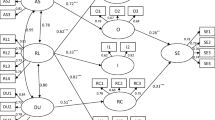Abstract
The study determined how students assess the various components of their science laboratory environment. It also identified how the laboratory environment affects students’ learning outcomes. The modified ex-post facto design was used. A sample of 328 randomly selected students was taken from a population of all Senior Secondary School chemistry students in a state in Nigeria. The research instrument, Science Laboratory Environment Inventory (SLEI) designed and validated by Fraser et al. (Sci Educ 77:1–24, 1993) was administered on the selected students. Data analysis was done using descriptive statistics and Product Moment Correlation. Findings revealed that students could assess the five components (Student cohesiveness, Open-endedness, Integration, Rule clarity, and Material Environment) of the laboratory environment. Student cohesiveness has the highest assessment while material environment has the least. The results also showed that the five components of the science laboratory environment are positively correlated with students’ academic performance. The findings are discussed with a view to improving the quality of the laboratory environment, subsequent academic performance in science and ultimately the enrolment and retaining of learners in science.

Similar content being viewed by others
References
Adelson R (2004) Instruction versus exploration in science learning. PsychNet, American Psychological Association 35(6):34–47. http://www.apa.org/monitor/jun04/instruct.html
Aladejana FO (2006) Concept of teaching. In: Ehindero OJ, Aladejana FO (eds) Introduction to the teaching profession. Literamed Publications Ltd, Lagos, pp 12–19
American Association for the Advancement of Science (1993) Benchmarks for science literacy. Oxford University Press, New York
Bajah T (1983) Teaching integrated science creatively. Ibadan University Press, Ibadan, pp 51–59
Bigge O (1993) Learning to teach in secondary school, 2nd edn. Susan Capel & Co., London and New York
Bredderman T (1983) The effects of activity-based elementary science programme on students’ outcomes and classroom practices. Rev Educ Res 53(4):499–518
Burton RR, Stanley E (1968) The psychology of learning. Robert Bordger and A.E.M. Seaborne Penguin Books, pp 40–45
Chin TY, Wong FL, Angela (2004) Pupils classroom environment perceptions, attitude and achievement in science at the upper primary level. J Curriculum Leadersh 40(2):34
Combs AW, Snugg D (1995) Psychology applied to teaching, Biehler, 2nd edn. Houghton Mifflin Company, GA, USA, pp 23–67
Dorman JP (1995) Associations between school-level environment and science classroom learning environment in secondary schools. Res Sci Educ 25(3):333–351
Fraser BJ (1986) Classroom Environment. Croom–Helm, London
Fraser BJ, O’Brien P (1985) Student and teacher perceptions of the environment of elementary school classrooms. Elem School J 85:567–580
Fraser BJ, Giddings GJ, McRobbie CJ (1993) Development and cross-national validation of a laboratory classroom environment instrument for senior high school science. Sci Educ 77:1–24
Goh SC, Young DJ, Fraser BJ (1995) Psychosocial climate and student outcomes in elementary mathematics classrooms: a multilevel analysis. J Exp Educ 64:29–40
Hanley S (1994) On constructivism. Maryland collaborative for teacher preparation http://www.inform.umd.edu/UMS+State/UMD-projects/MCTP/Essays/Constructivism.txt
Huitt W (2003) Constructivism. Educational psychology interactive. Valdosta State University, Valdosta. http://chiron.valdosta.edu/whuitt/col/cogsys/construct.html
Hung FU, Chin AK (1988) Sharing of experiences-application of discovery method to teaching. Educ J 16(1):85–96
Instructional Philosophy (2004) Classroom Environment. http://www.biologylessons.org/
Mayer RE (2003) Learning and instruction. Pearson Education, Inc, Upper Saddle River, pp 287–288
McRobbie CJ, Fraser BJ (1993) Association between student outcomes and psychosocial science environment. J Educ Res 87:78–85
Owokade OO (2006) Facilitating effective performance of students in mathematics, science and technology in secondary schools. Paper presented at the FGN-UNESCO Workshop for Inspectors, University of Lagos, Lagos, Nigeria, Dec 2006
Piaget J (1969) The Mechanism of perception. Routledge and Kegan Paul, London
Sherman LW (1995) A postmodern, constructivist and cooperative pedagogy for teaching educational psychology, assisted by computer mediated communications. In: Proceedings of CSCL 95’ Conference. http://www.edb.utexas.edu/csclstudent/Dhsiao/theories.html
Silberman CE (1973) The open classroom readers. Random Press, New York
Turpin T, Cage BN (2004) The effects of an integrated activity-based science curriculum on student achievement, science process skills and science attitudes. Electron J Lit Sci 3:1–17
Watson J (2000) Research designs, RGS 6035 http://www.ecourse.amberton.edu/grad/RGS6035E1/READ4.HTM
Welch WW, Walberg HJ (1972) A national experiment in curriculum evaluation. Am Educ Res J 9:373–383
Wilson BG (1996) Introduction: what is a constructivist learning environment? In: Wilson BG (ed) Constructivist learning environments. Educational Technology Publications, Englewood Cliffs, pp 3–8
Windschitl M (2002) Framing constructivism in practice as the negotiation of dilemmas: an analysis of the conceptual, pedagogical, cultural and political challenges facing teachers. Rev Educ Res 72(2):131–175
Wong AFL, Fraser BJ (1996). Environment attitude associations in the chemistry laboratory classroom. Res Sci Technol Educ 14:91–102
Quek CL, Wong AFL, Fraser BJ (1998, April). Teacher–student interaction among gifted chemistry students in Singapore secondary schools. Paper presented at the Annual meeting of the National Association for Research in Science Teaching, San Diego
Zandvliet DV, Buker L (2003) The Internet in B.C. classrooms: learning environments in new contexts. Int Electron J Leadersh Learn 7(15). http://www.ucalgary.ca/~iejll/volume7/zandvliet.htm
Author information
Authors and Affiliations
Corresponding author
Rights and permissions
About this article
Cite this article
Aladejana, F., Aderibigbe, O. Science Laboratory Environment and Academic Performance. J Sci Educ Technol 16, 500–506 (2007). https://doi.org/10.1007/s10956-007-9072-4
Published:
Issue Date:
DOI: https://doi.org/10.1007/s10956-007-9072-4




